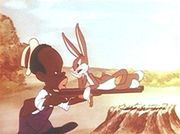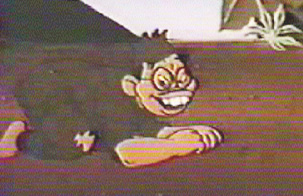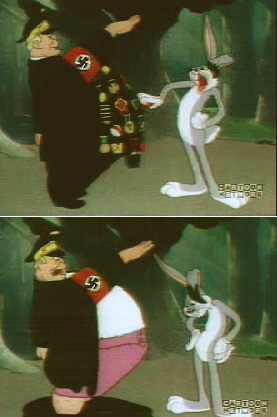|
We will be listing different Warner Brother Cartoons over time. Please return often to see one of many Looney Tunes cartoon adventures from an era of when cartoons were fun. If you believe something listed here is NOT public domain, but is owned by you or your client(s) click HERE and give us the particulars. |
|---|
|
Along with Mickey Mouse, Bugs Bunny was the most enduring American cartoon character of the 20th century. The acknowledged star of the Warner Brothers cartoon menagerie, Bugs was a cocky, wisecracking, good-hearted hare who battled Elmer Fudd, Daffy Duck and other slapstick nemeses in dozens of animated short films. Bugs's debut as a star was the 1940 short A Wild Hare, where he first uttered his trademark line, "What's up, Doc?" Credit for the Bugs Bunny character generally goes to Tex Avery, who developed a preliminary character created by fellow animator Ben "Bugs" Hardaway. (Many of the later Bugs Bunny cartoons were directed by Friz Freleng and Chuck Jones; the voice of Bugs was provided by Mel Blanc.) The shorts remain popular in TV reruns. |
 |
|---|
 ALL THIS AND RABBIT STEW
ALL THIS AND RABBIT STEW
|
This is a famous Tex Avery cartoon featuring Bugs Bunny. Circa 1941. Banned for its racist depictions of African Americans. Salvaged from poor quality copies and digitally restored for Historical and Educational purposes. |
|---|
 BUGS BUNNY NIPS THE NIPS
BUGS BUNNY NIPS THE NIPS
I. Freleng directed World War Two cartoon in 1944. This old cartoon is sometimes banned for its stereotypical depictions of Japanese soldiers. Salvaged from poor quality copies and digitally restored for Historical and Educational purposes.
|
 BUGS BUNNY HERR MEETS HARE
BUGS BUNNY HERR MEETS HARE
This an extremely rare and one of the MANY banned Bugs Bunny cartoons. This is the extremely rare I. Freleng cartoon from world war 2 where Bugs runs into Groebler who did flying stuff for Hitler. At the end Hitler goes "ahh himmel" and Bugs with a Russian accent comes out looking like Stalin? |
|---|
|
Cell Phone Reviews |
|---|
